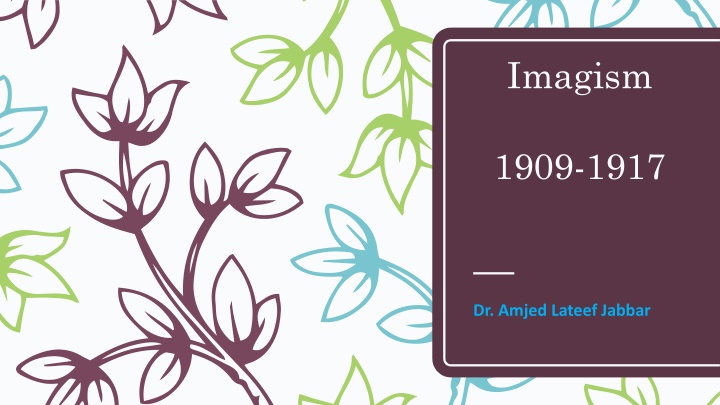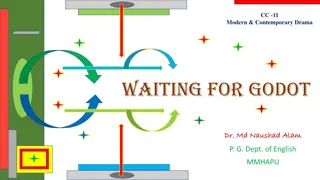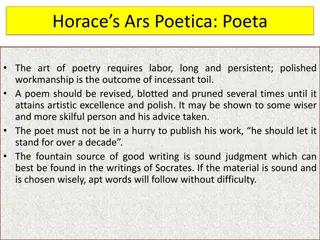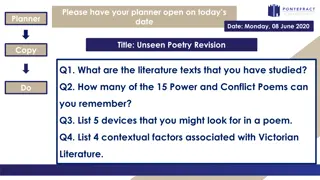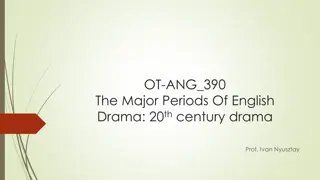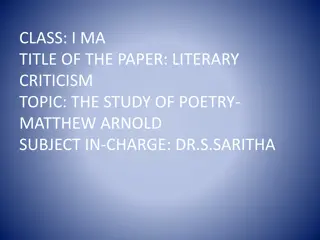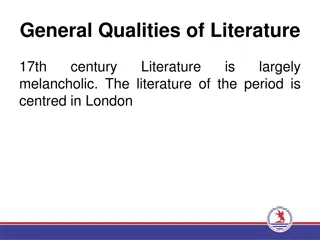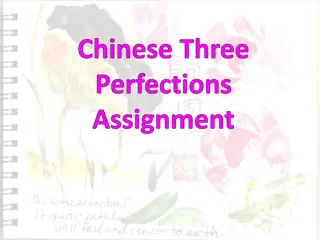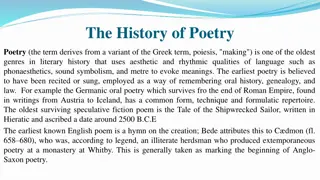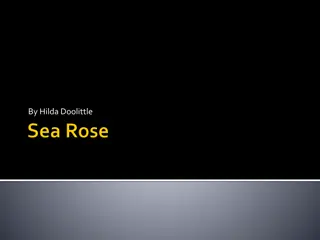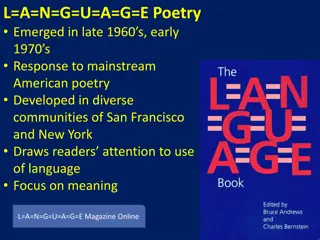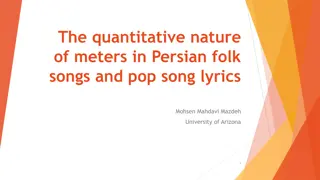Imagism: A Brief Overview of a Modernist Poetry Movement
Imagism was a poetic movement that flourished in Britain and the United States between 1909 and 1917, aiming to break away from the sentimentality of Victorian poetry. Influenced by French symbolists and Japanese haiku, imagist poets like Ezra Pound and Amy Lowell focused on creating concise, vivid images in their works. The movement is credited to T. E. Hulme, and other notable imagist poets include Hilda Doolittle and Richard Aldington, who often explored themes of war in their poems.
Download Presentation

Please find below an Image/Link to download the presentation.
The content on the website is provided AS IS for your information and personal use only. It may not be sold, licensed, or shared on other websites without obtaining consent from the author.If you encounter any issues during the download, it is possible that the publisher has removed the file from their server.
You are allowed to download the files provided on this website for personal or commercial use, subject to the condition that they are used lawfully. All files are the property of their respective owners.
The content on the website is provided AS IS for your information and personal use only. It may not be sold, licensed, or shared on other websites without obtaining consent from the author.
E N D
Presentation Transcript
Imagism 1909-1917 Dr. Amjed Lateef Jabbar
Imagism flourished in Britain and in the United States for a brief period that is generally considered to be somewhere between 1909 and 1917. As part of the modernist movement, away from the sentimentality and moralizing tone of nineteenth-century Victorian poetry, imagist poets looked to many sources to help them create a new poetic expression.
For contemporary influences, the imagists studied the French symbolists, who were experimenting with free verse (vers libre), a form that used a cadence that mimicked natural speech rather than the accustomed rhythm of metrical feet or lines. Rules of rhyming were also considered nonessential. The ancient form of Japanese haiku poetry influenced the imagists to focus on one simple image. Greek and Roman classical poetry inspired some of the imagists to strive for a high quality of writing that would endure.
T. E. Hulme is credited with creating the philosophy that would give birth to Imagism. Although he wrote very little, his ideas inspired Ezra Pound to organize the new movement. Pound s In a Station of the Metro is often cited as one of the purest of his imagist poems. Amy Lowell took over the leadership role of the imagists when Pound moved on to other modernist modes. Her most anthologized poems include Lilacs and Patterns.
Other important imagist poets include Hilda Doolittle, poem Sea Poppies reflects the Japanese influence on her writing, and whose Oread is often referred to as the most perfect imagist poem; Richard Aldington, who was one of the first poets to be recognized as an imagist and whose collection Images of War is considered to contain some of the most intense depictions of World War I; F. S. Flint, who dedicated his last collection of imagist poems, Otherworld: Cadences to Aldington; and John Gould Fletcher, whose collection Goblins and Pagodas is his most representative imagistic work. whose
Themes 1. War Several of the imagist poets used war as a theme of their poems and sometimes of their entire collections. One example is Aldington s Images of War, in which the poet draws upon his personal experiences in the trenches of World War I. This collection also includes poems that he wrote after the war, poems in which he uses a cynical tone to mark his disgust of societies that allow war to occur in the first place. The poem The Lover, which first appeared in this volume, is a fitting example. It brings together an interesting mix of his fears and suggests the sexual desires that he experienced during the war.
Pounds Cathay also employs the theme of war. Although Pound wrote these poems from translations of Li Po, an eighth-century poet from China, the original poems focused on war, a timely concern of Pound s, as the effects of World War I were much in his thoughts. Male poets were not the only ones affected by the war. Many of Doolittle s poems in her collection Sea Garden engage images of pain, suffering, and desolation. Some critics relate these images to the ravages of war felt by the entire population, including those who were left at home. Doolittle was married to Aldington at the time he served on the front lines and thus felt the full impact not only of her personal fears and sense of loss but also of Aldington s suffering. Many of the poems in Flint s Otherworld: Cadences also portray the devastation of World War I. In fact, he dedicated this work to his fellow poet Aldington because he was well aware of the effect that the war was having on his friend.
2. Sense of Place Flint, who lived all of his life in or near London, has many times been referred to as the poet of London. He grew up in the streets of this city and knew the sounds, smells, and colors so well that they permeated his poetry. His love of the city was not always an easy one, however, as espoused in some of his writings, such as his poem Courage, in which he awakens every day and hopes for the strength to face the city one more time without whining. On a lighter note is his To a Young Lady Who Moved Shyly among Men of Reputed Worth, written quickly at a dinner party in London. The original version of this poem did not meet the tenets of Imagism, so Flint rewrote it and titled it London. In this version, it became one of Flint s most admired poems.
John Gould Fletcher returned to his child-hood home in Little Rock, Arkansas, and there he wrote poems that would be collected in the book Ghosts and Pagodas. He eventually returned to Europe and then came back to the United States again. During his second return, he traveled across the Continent and looked at his homeland with fresh eyes. The result was his Breakers and Granite (1921), a sort of salutation to America. This collection demonstrates Fletcher s experiments with free verse and polyphonic prose, demonstrating the imagist influence on his work. The poems describe such diverse subjects as the Grand Canyon, the farmlands in New England, the small towns along the Mississippi River, elements of southern culture, and life on Indian reservations.
3. Nature Doolittle s Sea Garden is filled with images of nature: flowers, bushes, oceans, beaches, and more. Doolittle used nature in this collection to reflect on a variety of emotions, her sense of isolation, and suffering. Fletcher also employed nature in his poetry, beginning with his first collection Irradiations, in which he often refers to such natural elements as gardens, forests, and rain. Under the influence of Japanese haiku, which often portrays details in nature, Fletcher s poem Blue Symphony intertwines colors and images of trees in mists of blue to suggest seasonal changes. Lowell also reflected on nature in her experiments with polyphonic prose, such as in her Patterns, in which she envisions herself walking through a garden, as well as in The Overgrown Pasture. In her poem November, she describes many different types of bushes and trees as they are affected by the cold of approaching winter.
One of Flints earliest poems, The Swan, follows the imagist practice of conciseness and suggestiveness. The poem consists of several short lines, written in concrete terms that describe the movements of a swan through dark waters. The poem is filled with the colors found in nature, painting a precise image with words. The image of the swan gives way at the end to a symbol of the poet s sorrow.
4. Greek Poets Both Aldington and Doolittle were avid students of Greek literature and mythology. They both looked to the classical poets to find a model of excellence for their writing. Doolittle was perhaps most inspired by Greek poets, often alluding to Sappho in her works. Her poems that incorporate classical references are some of the most original. Only one poem by Sappho survived to modern times in its complete state. The rest of Sappho s poetry exists only in fragments. It is upon these fragments that Doolittle built some of her most fascinating poetry. Doolittle has been credited, by Greek scholars such as Henry Rushton Fairclough (as quoted in Hughes s book), for becoming so completely suffused with the Greek spirit that only the use of the vernacular will often remind the cultivated reader that he is not reading a Greek poet. Fairclough particularly refers to Doolittle s poem Hymen as exemplifying the influence of Greek poetry on her craft.
Style 1. Polyphonic Prose Amy Lowell was the imagist poet most heavily influenced by the practice of polyphonic prose, a term coined by Fletcher (who also enjoyed using this technique), but a practice that Lowell learned from the French poet Paul Fort (1872 1960). Lowell understood this form to be similar to free verse but only freer. She called it the most elastic form of poetic expression, as it uses all the poetic voices such as meter, cadence, rhyme, alliteration, and assonance. Written in this form, a poem appears like prose on the page, but the sound of the poem reveals its poetic character.
Lowell described this technique in her essay A Consideration of Modern Poetry, which she wrote for the North American Review (January1917). She employed this technique for the first time in her collection Sword Blades and Poppy Seed (1914), about which Aldington wrote an article in the Egoist commending the collection and suggesting that all young poets should read Lowell s poems to learn the technique. Aldington writes (as quoted in Hughes s book), I am not a bit ashamed to confess that I have myself imitated Miss Lowell in this, and produced a couple of works in the same style. Although Lowell s poetry was often criticized for lack of depth, many critics praised her use of language, especially her proficiency in using poly- phonic prose.
2. Free Verse Pound was responsible for creating six tenets designed to help poets understand what Imagism is and how it differed from other forms of poetry. Of these six, one was about free verse, which, according to the manifesto, would best express the individuality of the poet. The exact wording of this tenet is quoted in David Perkins s book, A History of Modern Poetry: From the 1890s to the High Modernist Mode: We believe that the individuality of a poet may often be better expressed in free-verse than in conventional forms. In poetry, a new cadence means a new idea. Free verse was one manner of escaping the need to rhyme. Pound thought that releasing poets from the need to rhyme would lead them to focus better on the image.
Pound was not original in this idea, as various forms of free verse had been used in classical Greek literature, in Old English literature (such as Beowulf), as well as in French, American, and German poetry. However, Pound and the other imagist poets took the meaning of free verse to new ground. They believed that rhythm expressed emotion, and the imagists understood, according to Perkins, that for every emotional state there is the one particular rhythm that expresses it. Therefore, limiting rhythm to the fixed stanzas, meters, and other rhythmic standards of conventional poetry disallowed a full rendering of those emotions. In other words, the individuality of the poet s emotions would be thwarted by following traditional rules, and thus the overall effect of the poem would become inauthentic or insincere. Thus, the imagists were encouraged to let go of the old standards and open up their emotions to the flow of words that was allowed in free verse. Of the imagist poets, the Americans, more so than their British cohorts, readily took advantage of free verse. The traditional rules of poetry had been created in Europe and therefore had a European character. Through the use of free verse, the American imagists felt that they could compose more individualistic poetry that spoke in an American voice.
There was controversy around this form, as many critics had trouble distinguishing the differences between so-called free verse and actual prose. So the question arose: What makes a poem a poem? Poetry, most critics argued, required form. Aldington defined his use of free verse as poetry in this way: The prose-poem is poetic content expressed in prose form (quoted from Hughes). Whereas Fletcher took a more visual and more general approach in attempting to express his understanding of the difference between prose and poetry, believing that all well-written literature could be referred to as poetry, so that it did not matter if poems were written according to very traditional rules or in free verse. In Hughes s book, Fletcher is quoted as saying: The difference between poetry and prose is . . . a difference between a general roundness and a general squareness of outline.
3. Common and Precise Language Another tenet in the imagist manifesto dealt with the specific use of language. Imagist poets were told to use the language of common speech, more like the language one would hear in conversation rather than the formal or decorative language often used in traditional poetry. Imagists were also told to be spare in their use of words, to practice using only the words that were needed to describe an image. They should be concrete in their language, to stay away from abstraction.
4. Image Pound s definition of what an image was in terms of imagist poetry is rather vague. He stressed that the language should be precise and concentrated in expressing this image, but he never quite defined what the image of the imagist movement was. One of the tenets of the imagist manifesto was the freedom of the poet to choose any subject that he or she wanted. So image was not related to subject matter. However, it is stated that one of the main purposes of poetry is To present an image (quoted from Hughes). This image should not be an abstraction. If an abstraction, such as an emotion, is to be expressed, indeed, it should be told, through an image. Aldington, as stated by Hughes, tried to be a little more specific in his definition of an image by stating that poets should try to create clear, quick rendering[s] of particulars without commentary. William Carlos Williams, who wrote an occasional imagist poem, may have defined the image best. Ideas are best expressed through things, Williams believed, and there was no better way to express things that contained ideas than through images. The imagists intent to focus on one image led them to embrace the poetry of Japan, especially haiku, which presents a single image in each poem.
5. Japanese Haiku Japanese haiku is an ancient form of poetry, originating about 1300 AD. Haiku is a precise poetic form, consisting typically of seventeen syllables in three lines. Japanese, which is syllabic rather than based on individual letters of an alphabet, is better suited to this form than is English. Therefore, even though the imagist poets became enamored of this form, they technically never wrote an authentic haiku. However, haiku greatly influenced their work. Matsuo Basho (1644 1694) is one of Japan s best-known haiku poets. His most famous poem of this type is a good example: An old pond . . . A frog jumps in The sound of water. In comparison is Doolittle s Oread (also taken from Harmer s book), which demonstrates the imagist attempt to practice haiku by writing simply and focusing on one image: Whirl up, sea whirl your pointed pines, splash your great pines on our rocks, hurl your green over us, cover us with your pools of fir.
